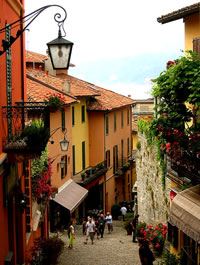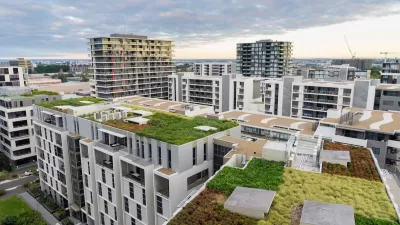BELLAGIO – No, not that Vegas hotel, but the ancient village of Bellagio, Italy – on the gorgeous rocky shores of Lake Como, a deep water lake that winds around the Dolomites in northern Italy. Here to cover a month-long summit about 21st century urban futures, I rented an apartment and rather quickly woke up to realize that, after many years writing about the virtues of mixed-use urban centers, I had never actually known a single residential night in one. Lots of nights in big hotels of course, but that’s not really the same thing as living in a residential unit of a small building over retail shops and restaurants.
BELLAGIO – No, not that Vegas hotel, but the ancient village of Bellagio, Italy – on the gorgeous rocky shores of Lake Como, a deep water lake that winds around the Dolomites in northern Italy. Here to cover a month-long summit about 21st century urban futures, I rented an apartment and rather quickly woke up to realize that, after many years writing about the virtues of mixed-use urban centers, I had never actually known a single residential night in one. Lots of nights in big hotels of course, but that's not really the same thing as living in a residential unit of a small building over retail shops and restaurants. Like someone advocating for transit who's never been on a bus, I suppose my affection for mixed use has been, while sincere and well informed, a bit abstract. The actual experience is a mixed bag of reactions.
 Most buildings in Bellagio village are two or three stories. It is the kind of urban layout planners are forever urging on small cities and districts of larger ones. Here, the restaurants mostly cater to the tourists here for a few days, whose numbers swell every half hour or so as ferries deliver even more of them with their cameras and pockets full of euros. The tourists cross the piazza and stream up and down the salitas, a series of steeply tiered cobblestone walkways. I cannot help noticing how many of them are, well, carrying weight not suitable for these up and down climbs. But just try to find an overweight local. The reason: if you live here, you probably walk everywhere you go. Vehicles are permitted only on a narrow perimeter road which snakes around the village with an upper and lower spine connected by a series of blind curves. With pedestrian permission, cars and small delivery trucks navigate a counterclockwise course.
Most buildings in Bellagio village are two or three stories. It is the kind of urban layout planners are forever urging on small cities and districts of larger ones. Here, the restaurants mostly cater to the tourists here for a few days, whose numbers swell every half hour or so as ferries deliver even more of them with their cameras and pockets full of euros. The tourists cross the piazza and stream up and down the salitas, a series of steeply tiered cobblestone walkways. I cannot help noticing how many of them are, well, carrying weight not suitable for these up and down climbs. But just try to find an overweight local. The reason: if you live here, you probably walk everywhere you go. Vehicles are permitted only on a narrow perimeter road which snakes around the village with an upper and lower spine connected by a series of blind curves. With pedestrian permission, cars and small delivery trucks navigate a counterclockwise course.
Every morning I climb the winding paths up a steep hill for about 15 minutes to the conference center. Coming down at day's end, the immense advantages of mixed use and some irritating features become clear. The advantages: you're never far from anywhere you need to go. No fossil fuels are in play. And there's no need for those trunk-engorging trips to CostCo for a month's worth of anything. Little shops are around for getting food and other necessities. There's always something going on.
And that is the irritating side. Things are often going on when you would prefer to sleep. Locals working the restaurants head for bars where they noisily celebrate the night. Tourists, only seen during the day, take unnatural karaoke voice in sidewalk clubs at these late hours. Then, after precious few hours of calm, early morning vendor deliveries and refuse collectors unleash their talents for slamming doors and full pallets of supplies or emptied refuse barrels down on stone streets. Mercifully, the church bells do not thunder their theological reminders until 7:30.
After a couple more weeks, I'll check my withdrawal symptoms on driving. But for now, the sense of living in a small but truly urban center is getting stronger – along with my legs.

Planetizen Federal Action Tracker
A weekly monitor of how Trump’s orders and actions are impacting planners and planning in America.

Chicago’s Ghost Rails
Just beneath the surface of the modern city lie the remnants of its expansive early 20th-century streetcar system.

San Antonio and Austin are Fusing Into one Massive Megaregion
The region spanning the two central Texas cities is growing fast, posing challenges for local infrastructure and water supplies.

Since Zion's Shuttles Went Electric “The Smog is Gone”
Visitors to Zion National Park can enjoy the canyon via the nation’s first fully electric park shuttle system.

Trump Distributing DOT Safety Funds at 1/10 Rate of Biden
Funds for Safe Streets and other transportation safety and equity programs are being held up by administrative reviews and conflicts with the Trump administration’s priorities.

German Cities Subsidize Taxis for Women Amid Wave of Violence
Free or low-cost taxi rides can help women navigate cities more safely, but critics say the programs don't address the root causes of violence against women.
Urban Design for Planners 1: Software Tools
This six-course series explores essential urban design concepts using open source software and equips planners with the tools they need to participate fully in the urban design process.
Planning for Universal Design
Learn the tools for implementing Universal Design in planning regulations.
planning NEXT
Appalachian Highlands Housing Partners
Mpact (founded as Rail~Volution)
City of Camden Redevelopment Agency
City of Astoria
City of Portland
City of Laramie





























